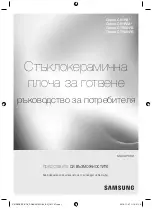
12
progress
Before carving, leave the joint to rest for
at least 15 minutes, so that the meat juices
do not run out.
To reduce the build up of smoke in the
oven, it is recommended to pour a little water
in the roasting pan. To prevent condensation
forming, add water several times. The plates
can be kept warm in the oven at minimum
temperature until required for serving.
Important!
Do not line the oven with
aluminium foil and do not place
baking trays, cookware, etc. on
the oven floor, as the heat that
builds up will damage the oven
enamel.
Cooking times
Cooking times may vary, depending on
the composition, ingredients and amount of
liquid in the individual dishes.
Make a note of the settings you used
during your first cooking and roasting
attempt so that you can record your
experiences for the next time you want to
prepare the same foods.
Based upon your own experiences, you
will be able to modify the values given in the
tables.
Practical tips
Baking:
Most baking is done at a medium
temperature (150°C - 200°C). The oven must
therefore be preheated for about 10 minutes.
Do not open the oven door before 3/4 of
the baking time has expired.
Short-crust pastry is baked in a spring-
form tin or on a tray for up to 2/3 of the baking
time and then garnished before being fully
baked. This further baking time depends on
the type and amount of topping or filling.
Sponge mixtures must be of slow dropping
consistency. Too much liquid would prolong
the baking time unnecessarily.
If two baking trays with pastries or biscuits
are inserted into the oven at the same time,
there must be a gap of one shelf level between
the trays.
If two loaded baking trays are inserted in
the oven at the same time, the positions of the
top and bottom trays must be swapped and
turned about 2/3 through the baking time.
Roasting:
Do not roast joints weighing less than 1
kg. Smaller pieces could dry out when
roasting. Dark meat that should be well
cooked on the outside but remain medium to
rare on the inside must be roasted at a higher
temperature (200°C - 250°C).
White meat, poultry and fish, on the other
hand, require a lower temperature (150°C -
175°C). For shorter cooking times, the
ingredients for sauces are added to the
roasting tin right at the beginning. Otherwise
add them in the last half hour.
You can use a spoon to test whether the
meat is cooked: If it makes no indent, the
meat is cooked through. Roast beef and fillet
of beef, which should remain pink inside,
must be roasted at a higher temperature for a
shorter time.
If meat is to be cooked directly on the
oven shelf, insert the roasting pan in the shelf
level below to catch the juices.
Содержание PHN 1310
Страница 74: ......
Страница 75: ......
Страница 76: ...76 progress 35906 2101 06 08 R A www progress hausgeraete de ...













































